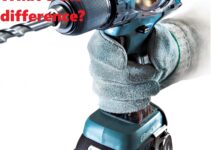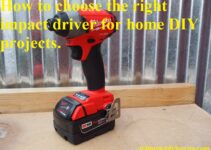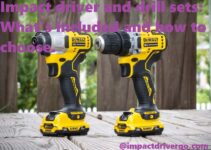Are you confused between an impact driver and a cordless drill? You’re not alone. Both are extremely versatile tools, but you may wonder which one is right for your DIY project.
This guide will explain the differences between an impact driver and a cordless drill to help you make the best decision for your needs.
Having the right power tool for the job can save you valuable time and make your project much easier. When you’re in the market for a new power tool, it can be overwhelming trying to determine which one is best suited for your needs. In this guide, we will compare two of the most commonly used tools – impact drivers and cordless drills – so that you can decide which one is a better fit for you.
We’ll start by looking at what an impact driver and a cordless drill are and then compare their features to help you decide which one is better suitable for your needs. By the time we’re done, you should have all of the information necessary to make an informed decision about whether an impact driver or cordless drill is right for your next project.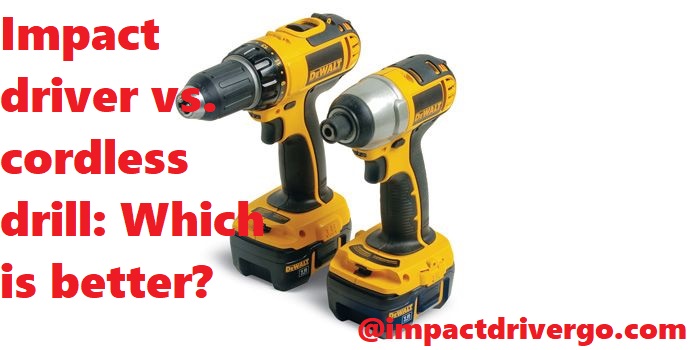
Explanation of the topic
This complete guide provides an in-depth examination of the differences between an impact driver and a cordless drill. Impact drivers are a growing common tool among DIYers and professionals due to their power, effectiveness, and versatility, whereas cordless drills are the more traditional hand-held electric drill used for everyday tasks.
In order to decide if the impact driver is a better choice over the cordless drill for any given task, we must first consider what each tool is capable of doing. In its most basic form, a cordless drill is designed to drive screws as well as other fasteners quickly and efficiently into wood or metal while also providing additional functionality such as drilling holes. Cordless drills are also equipped with variable speed settings so that they can accommodate different materials with different levels of torque (the force at which the bit spins).
Meanwhile, an impact driver has all of these features plus more. As suggested by its name, an impact driver uses changes in speed plus increased force (torque) at certain points during its operation to achieve greater results than a standard cordless drill. Additionally, an impact driver’s ability to both loosen soil from fasteners and tighten them back down makes it incredibly useful for work on car engines or complicated electronic components where excessive force must be controlled carefully.
It is clear that despite their similarities, there are several distinct advantages of using an impact driver over a cordless drill. From this information and based on these two tools’ capabilities you can make your own decision about which one might be better suited for your task at hand – whether you’re working in the garage on something simple or taking on a bigger project that requires precision and strength – you can now decide confidently whether you will use an impact driver or a cordless drill as part of your home repair arsenal!
Importance of knowing the difference between an impact driver and a cordless drill
In a nutshell, a cordless drill has a chuck that uses two gripping jaws to allow you to use it with non-cylindrical tools and accessories. This is great for drilling into materials, but not ideal when you need to drive screws using long bits. This is where an impact driver comes in.
An impact driver looks more like an unassuming electric screwdriver than its predecessor does—it’s about half the size of a regular drill and fits comfortably in one hand. Despite the size difference, however, it’s much more powerful due its incredibly robust motor and unique design. Rather than relying on just the torque from the drill bit itself, an impact driver has an additional mechanism that slams against its head which gives it greater force than any cordless drill could dream of delivering. In addition to this great power, it also has more customization options thanks to its variable speed setting and reverse function for quickly switching between driving and purging screws.
Finally, this difference in design also makes them far easier to use. Thanks to the torque delivered by the dual action mechanisms, pilot holes are no longer needed when installing fasteners while stripped heads are a thing of the past as the action reduces significantly if you begin driving into a head that’s already been over-tightened – allowing you to pull out any jammed debris and start over again without worrying about ruining your project!
Understanding Impact Driver and Cordless Drill
When it comes to answering the question of which tool is better for a particular job – impact driver vs. cordless drill – it’s all about understanding the capabilities of each tool and what job you’re trying to accomplish. To make informed decisions, there are some general considerations and specifications to look for when shopping for either tool.
Impact Drivers are specifically designed for fastening applications—driving in wood or machine screws, lag screws, circuit boards and more. They provide more torque than other power tools because they transfer impact energy into the bit as it rotates, thus eliminating cam-out—the situation where the bit slips out of screw recess while driving in tight spots. They also typically have a smaller head than regular drills which allows them to access tighter spaces better than traditional cordless drills. Not having any clutch means they usually run at one speed, although most have variable speeds with greater torque at lower speeds.
Cordless Drills on the other hand serve both drilling and fastening applications but generally offer less overall power and torque than Impact Drivers because their entire purpose is not dedicated towards driving alone. While an Impact Driver is extremely good for driving applications such as wood screws or lag bolts into studs and joists where an enormous amount of forward pressure is necessary, a Cordless Drill should always be preferred over an Impact Driver when there’s a possibility of drilling into metal or masonry materials like brick or concrete block. This is because an Impact Driver can cause enough vibration to cause drill bits to shatter if used frequently against hard surfaces such as aluminum sheeting or brick walls & mortar joints (sic). The extra torque also means that certain screwdriving operations may be faster with a Cordless Drill since the user can opt for higher speeds versus a slower speed with high torque settings offered by most Impact Drivers. Additionally, having two speed settings (low speed/high torque; high speed/low torque) provides flexibility that many users find beneficial when performing multiple tasks.
Definition of an Impact Driver
An impact driver is an extremely powerful power tool that utilizes a combination of hammering and rotational forces to drive in and tighten screws, bolts and other fasteners. It is similar to a traditional cordless drill, but it has the added feature of rapid hammering action. This hammering action allows the tool to quickly drive even large screws into thicker materials without the need for additional force from the user. Increasingly popular among do-it-yourselfers, impact drivers are available in both cordless and corded models, with some models providing adjustable speed settings for maximum versatility.
Cordless drills differ from impact drivers primarily in that they are made up of different components: a chuck to hold the bit, a motor that generates torque and a trigger switch to start and stop the drill. Cordless drills tend to be lighter than their counterparts and can deliver up to two times more torque than an impact driver. They also typically have adjustable clutch settings, allowing users greater precision when drilling into different materials or applying different levels of torque on fasteners. Both tools can be used for general drilling tasks such as making holes, countersink screw heads or driving lag screws; however, cordless drills are usually better suited for smaller holes or lighter material types while impact drivers are preferred when working with heavier materials or demanding applications such as deck building projects.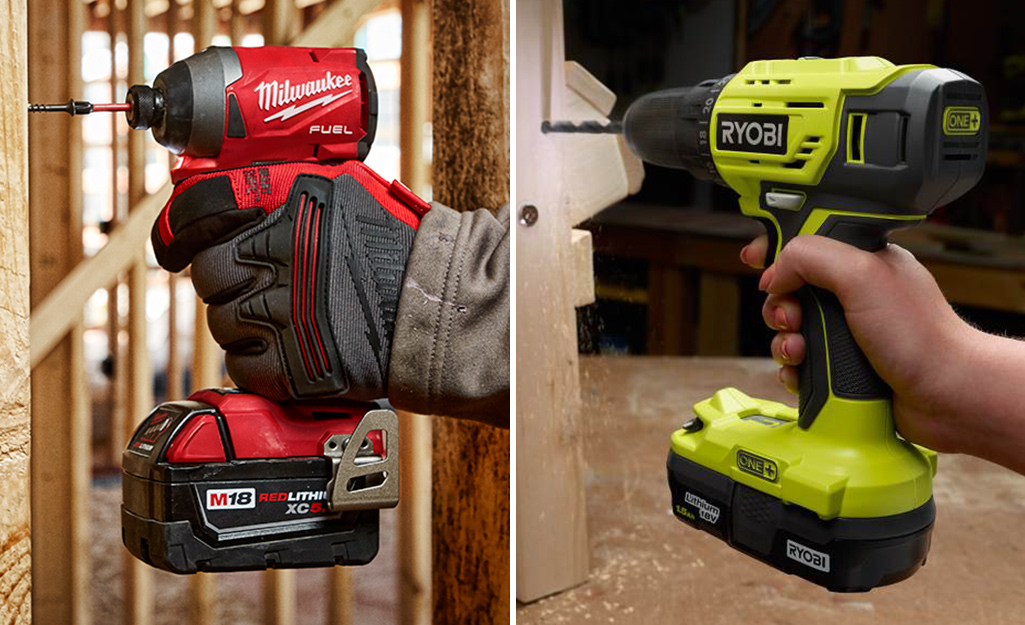
Definition of a Cordless Drill
A cordless drill is a handheld power tool powered by rechargeable batteries. It has a large range of applications in the construction, automotive and manufacturing industries thanks to its ability to perform a variety of drilling and fastening tasks. A cordless drill’s functions can range from simple drilling and screw driving operations to more complex tasks like grinding, cutting, polishing or sanding.
The components of a cordless drill can vary depending on its application but typically consist of an electric motor housed within a frame that contains two handles and several speed settings for different types of applications. Power is provided by one or two removable rechargeable battery packs placed within the frame that are designed to operate with the appropriate charger system.
Cordless drills are used when flexibility and portability are key considerations in home improvement or DIY projects.
Differences between the two tools
Choosing between an impact driver and a cordless drill can seem like a daunting task with so many options available on the market. It is important to have a good understanding of the differences between these tools in order to make an informed decision.
Impact drivers use a unique percussion mechanism to deliver more torque than traditional drills. This makes them useful for driving large lag screws and other fasteners that require extra power. Their compact design also makes them ideal for tight spaces or overhead tasks, as they produce less strain on arms and shoulders.
Cordless drills are capable of drilling into softer materials like plastic, aluminum, and even some woods easily, but also provide enough torque for harder materials such as masonry or concrete. Their size and portability make them perfect for large projects like assembling furniture or cabinets.
Both tools have their advantages when it comes to tackling projects around the home or job site, but choosing between the two boils down to what kind of project you are doing and the desired result you wish to achieve. An impact driver is great for fastening applications but may not be as efficient at drilling holes, whereas a cordless drill is ideal for screwing in wood screws yet may not perform as well when working with dense material like concrete.
When to use an Impact Driver vs. Cordless Drill
Impact drivers and cordless drills are both great tools to have in your workshop, but they are designed to fulfill two different uses. It is important to weigh the advantages and disadvantages of each before deciding which one is right for your job.
Impact drivers: Impact drivers are great for driving large screws through heavy-duty materials like metal or hardwood, which require a lot of torque to prevent stalling or breaking the screw. They also do well in tight spaces, since their small size helps them reach into tight corners, and since their motor doesn’t rotate, it is much easier to control.
When using an impact driver, you should always use a high quality bit because the rotational force can cause cheaper bits to break or wear quickly. You should also be aware that impact drivers tend to be much louder than other tools because of the bumps and thumps caused by the rotational force.
Cordless drills: Cordless drills are best used when drilling holes and driving smaller screws into materials that don’t require as much torque as larger projects. They come in both brushless and brushed models, giving you an option of better battery life with brushless models, or more power with brushed models. Cordless drills also have adjustable clutches that let you set it for a specific depth so you won’t strip out material if you don’t stop drilling when needed.
Conclusion: Ultimately, whether an impact driver or cordless drill is better for your job depends on what type of material needs drilling or screwing and how large the screw/hole needs to be drilled. Both tools offer significant advantages over traditional alternatives such as impacting wrenches or hand drills/screwdrivers – however determining which one is right for your project starts with understanding how they operate differently from one another while also taking into account cost efficiency and practical application before making a decision which one will work best for your project!
Different applications for each tool
Cordless drills and impact drivers have distinct tasks they are best suited for. While a cordless drill is a great choice for most drilling applications, an impact driver is the best choice when working with screws and bolts.
Cordless drills: When you think of a lot of drilling applications, do-it-yourself projects, the first tool that typically comes to mind is the cordless drill. It has two speeds (high and low), allowing you to drill through softer material, like wood or plastic at high speed, then switch to low speed when using metal-tipped bits. This two-speed setting also makes it easier to drive large screws with more control as it gives you more torque at lower speeds. Additionally, some cordless drills come with a clutch setting which allows you to control how much torque is applied so that you don’t damage the screw head or material being drilled into by over-tightening. All these features make it ideal for home improvement projects where you’ll be doing drywall work or assembling furniture.
Impact drivers: Impact Drivers are ideal for use when driving in long screws and bolts into hard materials like concrete or masonry blocks, thanks to its high power output and fast spinning head that generates hammering forces on the bit tip. This kind of force allows the bit to shatter tough surfaces with ease, providing faster screwing times than your typical cordless drill can achieve without risking damage to the screw head from over tightening. The only downside is that due to their increased power output they require higher voltage lithium ion batteries which can be bulkier than those found on regular cordless drills making them bigger in size and less portable than their counterparts.
Types of projects that require an impact driver
An impact driver is ideal for jobs that require a high amount of torque but low speed. This type of tool is particularly well-suited for driving fasteners into hard surfaces, such as masonry or steel. Impact drivers are very useful in applications like constructing cabinets, decks, fences and installing window or door frames.
Their superior power also makes them well suited for removing fasteners. Since they generate so much torque at low speeds, they can break loose even stubbornly stuck screws without damaging them or the screw’s head. In addition to these standard tasks, you should also consider using an impact driver when working on projects that require force-multiplying power such as auto body repair and mechanics.
In many cases an impact driver will deliver much more torque than competing methods such as using a cordless drill in hammer mode. When the project involves driving screws into soft materials like wood, an impact driver won’t be necessary and a cordless drill may provide all the force you’ll need to complete the job quickly and efficiently.
Types of projects that require a cordless drill
A cordless drill should be used when tackling appropriate tasks where torque is more important than speed. These types of projects require a driver bit which causes the screw to move in a circular motion, as opposed to an impact driver that moves in a linear motion. Driving various screws into wood or metal, for instance drilling holes for nailing is the type of task perfectly suited for cordless drills.
Additionally, removing and attaching bolts or screws may require the use of an adapted socket on the driver bit. Be sure you’re using the right type of bits for your project; cordless drills should also not be used when heavy duty drilling is required.
Maintenance and Safety Tips
In order to ensure peak performance from either a cordless drill or impact driver, it’s important to know how to care for and maintain them. Follow these maintenance tips for both tools:
- Clean the bit or driver frequently.
• Adjust torque and speed settings as needed.
• Check the chuck for wear an tear.
• Make sure you’re using the right bits for the job.
• Recharge battery packs properly and in a timely fashion.
Additionally, safety is always key when using power tools of any kind — here are some essential safety tips to keep in mind when working with either a cordless drill or impact driver:
- Always wear eye protection when operating power tools.
• Never unplug your tool by pulling on the cord; always grip around the plug itself.
• Ensure your workspace isn’t cluttered, to help reduce tripping hazards while working and moving around with your tool fully charged or plugged in.
• Avoid gloves while operating power drills as you may lose grip and become injured if touching any surfaces when handling powertools likecordless drills as they may be exposed to sharp edges that could leave cuts in case of unprotected contact with hands.
Maintenance tips for both tools
When it comes to proper maintenance of both impact drivers and cordless drills, there are a few key tips to follow. To ensure your tools work well and last longer, regularly read and follow the user manual that came with your tool. On top of regular cleaning, lubrication of moving parts such as the chuck and clutch is also important. It is important to check the battery charge of your cordless drill every once in awhile, as leaving a discharged battery unused can cause it to lose its optimum voltage over time. For both types of tool, always make sure that there is nothing stuck on the tip or in between the teeth before using them.
In addition, always take precaution when working with these tools – use protective eyewear and ear protection in case any pieces fly off during high powered turning or impact movements. As for storage of these tools, you should let them cool down after use before putting them back in their cases for extended periods as this may reduce service life expectancy due to expansion from heating combined with stagnated lubricants from low usage over time.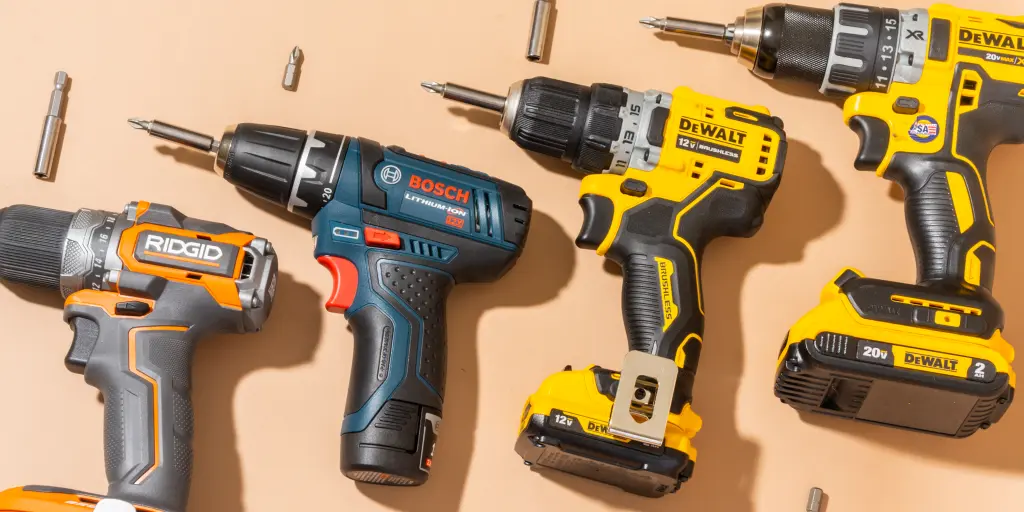
Conclusion
In conclusion, an impact driver or a cordless drill are both valuable tools with different capabilities and features. When selecting the best tool for the job, consider the size of the task, power requirements, cost, portability and budget.
Impact drivers are ideal for driving long screws into dense materials such as concrete and hardwood without causing cam-out or damaging the screw head. Cordless drills can be used to drill holes in wood and masonry in addition to fastening screws.
Whichever type of tool you decide upon, make sure that it has all the necessary safety functions and is well maintained so it can work effectively and safely every time.
FAQs
Which is better drill or impact driver?
It depends on the task at hand.
Can I use my cordless drill as an impact driver?
No, they are two different tools with different functions.
Can I use an impact driver as a drill?
Yes, but it may not be as effective as a drill for certain tasks.
What’s the difference between a cordless drill and impact driver?
A cordless drill is better for drilling holes and driving screws, while an impact driver is better for driving long screws and bolts.
Why use an impact driver vs a drill?
An impact driver provides more torque and is better for driving long screws and bolts.
When should you not use impact driver?
An impact driver should not be used for delicate tasks or for drilling holes.
Which type of drill is best?
It depends on the task at hand. A cordless drill is more versatile, while a corded drill provides more power.
Can I use impact driver to drill concrete?
No, an impact driver is not designed for drilling into concrete.
Is it worth buying an impact drill?
It depends on the tasks you need to perform. If you frequently drive long screws and bolts, an impact driver may be worth the investment.
Which type of impact driver is best?
It depends on the task at hand. A cordless impact driver is more versatile, while a corded impact driver provides more power.
See Also-
- Best 12v impact driver
- Best battery impact driver
- Best bit set for impact driver
- Best brushless impact driver
- Best cordless impact driver
